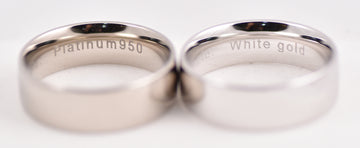Als het aankomt op het selecteren van het ideale metaal voor uw sieraden, met name voor verlovingsringen en trouwringen, komen er vaak twee populaire opties in aanmerking: platina en witgoud. Beide metalen hebben hun eigen unieke kwaliteiten en aantrekkingskracht, waardoor de beslissing een uitdaging is. Om een weloverwogen keuze te maken, is het essentieel om de kenmerken, duurzaamheid en esthetiek van elk metaal te begrijpen.
Platina: tijdloze elegantie en duurzaamheid
Platina is een natuurlijk wit metaal, bekend om zijn tijdloze elegantie en duurzaamheid. De natuurlijk witte glans vervaagt of verkleurt niet na verloop van tijd, waardoor uw sieraden generaties lang mooi blijven. Deze opmerkelijke weerstand tegen slijtage maakt platina de beste keuze voor verlovingsringen, waarbij duurzaamheid en levensduur van het grootste belang zijn.
Een van de opvallende kenmerken van platina is de zuiverheid. In tegenstelling tot witgoud, dat een legering is van goud en andere metalen, zijn platina sieraden meestal 95% zuiver. Deze hoge mate van zuiverheid maakt platina hypoallergeen, waardoor het een uitstekende keuze is voor mensen met een gevoelige huid.
Bovendien is platina aanzienlijk dichter dan goud, waardoor het een substantieel gevoel geeft dat velen aantrekkelijk vinden. Het is ook beter bestand tegen krassen en deuken, waardoor het een ideale keuze is voor mensen met een actieve levensstijl. Na verloop van tijd ontwikkelt platina een natuurlijke patina, waardoor het karakter wordt versterkt en de sieraden een unieke charme krijgen.

Witgoud: veelzijdigheid en betaalbaarheid
Witgoud is daarentegen een legering van goud gemengd met andere witte metalen, zoals palladium, nikkel of zilver. Het wordt vervolgens bedekt met een dunne laag rhodium, een edelmetaal dat de witte kleur versterkt en een beschermende laag biedt tegen aanslag. Deze plating kan echter na verloop van tijd slijten, waardoor periodiek opnieuw moet worden geplateerd om de oorspronkelijke glans te behouden.
Een van de belangrijke voordelen van witgoud is de veelzijdigheid ervan. Het kan worden verwerkt in ingewikkelde ontwerpen en is relatief kneedbaarder dan platina, waardoor juweliers gedetailleerde en sierlijke stukken kunnen creëren. Bovendien biedt witgoud een budgetvriendelijkere optie voor degenen die op zoek zijn naar de elegante look van platina zonder het hogere prijskaartje.
Het is echter cruciaal om te overwegen dat sommige personen allergische reacties kunnen hebben op het nikkelgehalte in witgoudlegeringen. Om dit probleem aan te pakken, gebruiken veel juweliers nu nikkelvrije legeringen, waardoor witgoud een veiligere keuze is voor mensen met een gevoelige huid.
Het nemen van de beslissing: persoonlijke voorkeur en levensstijl
Uiteindelijk komt de keuze tussen platina en witgoud neer op persoonlijke voorkeur, levensstijl en budget. Als u prioriteit geeft aan duurzaamheid, zuiverheid en een substantieel gevoel, is platina de ideale keuze. De natuurlijke witte glans en hypoallergene eigenschappen maken het een uitstekende investering voor een leven lang dragen.
Aan de andere kant, als u de voorkeur geeft aan veelzijdigheid, ingewikkelde ontwerpen en een meer betaalbare optie, dan is witgoud misschien de juiste keuze voor u. Houd er wel rekening mee dat er af en toe onderhoud nodig is, omdat de rhodiumlaag na verloop van tijd afslijt.
Voordat u een beslissing neemt, is het raadzaam om een gerenommeerde juwelier te raadplegen die u kan adviseren op basis van uw voorkeuren en vereisten. Overweeg daarnaast om verschillende stukken van beide metalen te passen om te zien welke het meest bij u past.
Of u nu kiest voor de blijvende elegantie van platina of de veelzijdigheid van witgoud, beide metalen kunnen prachtige en geliefde sieraden opleveren die uw stijl weerspiegelen en de tand des tijds doorstaan.

















